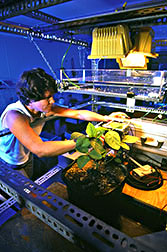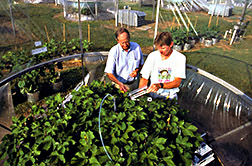The Year Sugar Baby Died
The year was 1983, the place was Indiana, and something terrible was happening to Sugar Baby.
A mysterious blight attacked this popular, super-sweet, table-sized watermelon, causing its leaves to yellow and the plant to fail just as the plump green fruits were developing.
This melon malady ravaged between 6,000 and 7,000 acres in southwestern Indiana, damaging several melon varieties and hitting about 100 farmers hard in the pocketbook. Panicked growers were looking for anything to stop the disease they called yellow crown blight.
"Southwestern Indiana is one of the larger melon producing areas east of the Mississippi," says Purdue professor James E. Simon, who is with the university's research and extension unit. "And since we're the largest melon-producing area in the Midwest, we had a real incentive to solve this problem fast."
To find the cause of the melon blight, Simon enlisted a team of scientists including Agricultural Research Service plant pathologist Richard A. Reinert. The team’s diagnosis: acid soil conditions leading to nutritional imbalance (magnesium deficiency and manganese toxicity), along with ozone—a major air pollutant.
When Reinert and his colleagues talk about ozone, they don't mean the kind in the stratosphere that protects living things from harmful ultraviolet radiation. The ozone at ground level comes from auto emissions reacting with sunlight. This kind damages plants by robbing them of the power to synthesize food. Estimated cost of the damage for all crops: $4 to $5 billion annually in the United States.
By 1990, Indiana growers were on the mend, thanks to different watermelon varieties, such as Crimson Sweet, and improved soil nutrition. The very ozone-sensitive varieties like Sugar Baby are no longer grown.
Simon says the state’s growers earned $7.8 million from watermelons in 1994, putting Indiana among the nation’s top 10 producers. Texas, Georgia, and California head the list, producing $60, $58, and $55 million worth, respectively.
"Not only did dedicated research by Richard Reinert help solve this complex environmental problem, but also by correctly identifying its cause, he helped save growers thousands of dollars in unnecessary sprays they had been using," Simon says.
Dealing With an Unseen Menace
Indiana was not the only place where ozone damaged watermelons. "My colleagues from as far away as Spain and as close by as here in the Carolinas saw similar problems," Reinert says.
But the scientists faced another challenge after learning the cause of yellow crown blight: They had to convince many growers that something they could not see or smell was injuring their crops. Some farmers, believing they were dealing with a new biological threat, poured on agricultural chemicals.
An important lesson learned from the melon case was the need to correctly diagnose a problem before trying to solve it, Simon emphasizes.
"It was a real education and outreach effort—in addition to the science," adds Reinert.
Yellow crown blight was a dramatic example of how a combination of factors, including air pollution, can damage crops. But ozone is usually a more subtle thief of farm profits than in the Sugar Baby case.
"With most crops grown in the field, you're not likely to see evidence of damage," says plant pathologist Allen S. Heagle. He is Reinert's colleague in the ARS Air Quality-Plant Growth and Development Research Unit at Raleigh, North Carolina. "Visible injury looks like normal aging, but there is a consistent decrease in yield each year."
David A. Westenbarger, an economist with USDA's Economic Research Service, has been tracking the cost of air pollution damage using data provided by ARS. In a paper published in the October 1995 Agricultural and Resource Economics Review, he credits Walter W. Heck, also with the Raleigh lab, and other ARS scientists with laying a scientific foundation for his economic research.
Westenbarger's study suggests tighter air pollution controls in the eastern United States could bring between $17 and $82 million in farm profits—mainly in Virginia, Maryland, and North Carolina. North Carolina has seen new businesses and a growing population, which benefit the state's economy but may have contributed to ozone problems.
“Ozone is not the greatest threat to U.S. agriculture,” Westenbarger cautions. “But when it's your farm and your yield not reaching top potential, it suddenly becomes important.”
He says ozone damage is not limited to farms near major urban areas. Weather patterns can move ozone well beyond city line—even to remote farms and forests. And stagnant air can cause pollutants to linger, adding to the effect.
“In the case of the melons in southwestern Indiana, the ozone damage came from being downwind of St. Louis and other urban areas,” says Simon. “We had very high temperatures, lots of humidity, and stagnant air—all of which played a role.”
Pinning Blame—for Sure
Proving ozone was the culprit required special equipment.
The Raleigh unit where Reinert works has open-top chambers where researchers can study a pollutant's effects in detail.
These chambers don't have a roof. A mechanical system in the chamber draws air from the outside, pushing it from the bottom to the top. Because the system is moving and filtering the air, outside pollutants don't get through.
“Open-top chambers offer scientists a special advantage in that outside pollutants can be filtered out,” says plant physiologist Joseph E. Miller, who oversees the research unit. “There are other systems for predicting pollution damage, some of which are used by ARS scientists. But this method allowed us to mirror Indiana air conditions.”
When Sugar Baby watermelons were grown in the open-top chambers and exposed to the same ozone levels found in Indiana, they also developed yellow crown blight. This helped confirm ozone damage.
Reinert, Simon, and others then grew other watermelon varieties in the same environment that killed Sugar Baby melons to find a variety that was not damaged.
 Agricultural engineer Robert Philbeck adjusts the system that delivers, controls, and monitors ozone and carbon dioxide concentrations in open-top field growth chambers. (K7442-2) |
Open-top chambers allow scientists to combine pollutants and can be easily adapted to researchers' study focus. "As global air pollution changes, this kind of flexibility becomes important," says Miller.
"In recent experiments, scientists in our unit studied the combined effects of ozone and carbon dioxide—an important aspect of global change."
While seed industry executives say ozone resistance doesn't top their list of desired plant traits, they acknowledge that it could become more important in the future if air pollution levels continue to rise. They also agree that ozone-resistant vegetables could fill a certain market niche.
"I'll tell you where ozone resistance could be of some use—truck farms," says John M. Reich, who is with Cal-West seed company in Woodland, California. "They grow fresh produce just outside major urban areas. New Jersey, for example, is a big truck farm area for New York City. Those producers are going to need ozone resistance sooner than the rest of us."
"In my experience, cantaloupes have been more environmentally sensitive than watermelons," says Paul Chung, senior plant breeder for Peto Seeds, also in Woodland. "In Europe—particularly in the greenhouses of France and Spain—we see cantaloupes that fail to thrive because of many factors, including air quality."
Miller adds there are already areas in the United States where ozone-sensitive vegetable crops cannot be grown.
There may be more demand for ozone resistance in the future as farmers come to appreciate its significance. But developing resistant plants doesn't happen overnight. Heagle has been studying crops and air pollution for most of his 27-year career.
"For example, in studies with clover, I identified 20 clones that proved better at withstanding elevated ozone levels, but that took a lot of time," Heagle says.
And he and his colleagues will keep testing various crops for varieties that can thrive in a more polluted world. Business and growth, both positive things, caught up with Sugar Baby, so it moved on. But in its place are melons made of tougher stuff. And if a similar problem happens to any crop—anywhere—Miller and his team of researchers hope to be ready. -- By Jill Lee, ARS.
"The Year Sugar Baby Died" was published in the October 1996 issue of Agricultural Research magazine.








